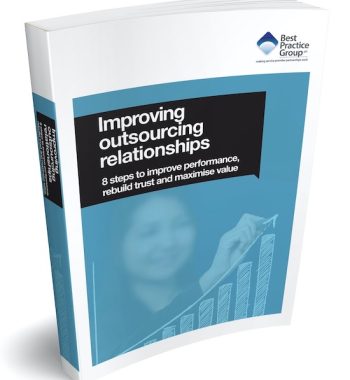 Fixed fees are often seen as the ultimate goal for buyers when negotiating a new project with a vendor. But while fixed-fee projects can offer a degree of certainty on both sides, if needs and costs are not determined with reasonable accuracy at the outset, and the contract terms not rigorously defined, costs can quickly spiral out of control, however good your initial intentions may have been. This article reviews when fixed fees are most appropriate, and what warning signs to watch out for to indicate that they are not.
Fixed fees are often seen as the ultimate goal for buyers when negotiating a new project with a vendor. But while fixed-fee projects can offer a degree of certainty on both sides, if needs and costs are not determined with reasonable accuracy at the outset, and the contract terms not rigorously defined, costs can quickly spiral out of control, however good your initial intentions may have been. This article reviews when fixed fees are most appropriate, and what warning signs to watch out for to indicate that they are not.
When to use a fixed fee
Negotiating a fixed fee for your latest project can give a sense of security and certainty regarding the overall costs involved. In order to ensure that a fixed-fee project is right for your business though, we would recommend you take a number of key criteria into consideration:
- Is the breadth and scope of the project fully understood by all parties and everyone involved?
- Is everyone aligned with, and signed up to the project success criteria?
- Does everyone understand their resourcing needs and both parties their specific responsibilities and accountabilities for the lifetime of the project? Have you removed grey areas whereby everyone knows the expectation?
- Is the time frame defined within a clear and precise project plan so all parties are aware of the resources needed to complete the project and their responsibility to source them?
- Is there minimal chance of your requirements materially changing over the lifetime of the project?
- Has there been an effective risk, or better, RAID strategy for the project up until now – which has resulted in a forum and logging of all risks, issues, assumptions and dependencies.
- Has impact, probability and proximity of these risks been well measured?
- Are there clear mitigation plans in place to deal with issues, risks and residual risks?
- Have all the critical dependencies been identified, evaluated and factored into the project timeline (including dependencies on other projects and corporate direction of travel)?
- Is there little or no chance of the project being stalled or deferred by any of the parties involved?
- Is the proposed contractual agreement solid, clear and well articulated? If there are any ambiguities, phrases or gaps that may lead to misunderstanding, then it is vital that these are ironed out before any fixed fee contract is entered into. For the safety and security of all parties, the terms and conditions, and schedules, must be rock solid and tie together seamlessly (the more gaps and “agreements to agree” the greater the risk and generally the buyer carries the cost).
The closer you are to ticking all of the above criteria, then the more sense a fixed fee may make.
Fixed-fee projects and the dangers of contractual ambiguity
The further you are from the above criteria, the better it will be for you to steer clear of a fixed fee contract. Fixed fee contracts (which work) rely on certainty – and the more unknowns or change factors, the greater the risk in setting a fixed fee. Ideally, the contract terms and conditions tie seamlessly with well-written schedules so all parties are completely clear about their responsibilities and financial exposure. Anything less than this can cause someone to lose out heavily, the repercussions of which will be felt by both sides.
Contractual uncertainty and ambiguity are the enemies of the fixed fee project, and there are a number of warning signs that you need to look out for before you sign. Just one ambiguous sentence within a contract can have the capacity to cause exponential damage to reputation, relationships and budget.
So before negotiating a fixed fee project it is essential that you iron out any vague, woolly or potentially misleading language. Be vigilant about removing any unhelpful caveats and assumptions from the contract so that you do not end up obliged to meet responsibilities that you are not capable of achieving. Furthermore, if your vendor has said it fully understands your requirements and outcomes and how it can achieve them, then be sure these needs and how the vendor’s solution will meet them are clearly explained throughout the contract.
It is also important to remember that even if you believe you are negotiating for a fixed-fee project, your vendor may not be on the same page as you. If ambiguous or vague phrases such as ‘estimated’, ‘indicative’ or ‘fixed duration’ are used in one part of a document, and ‘fixed fee’ in another, this is clearly opening up a future line of conversation and misunderstanding that is best pre-empted. It is crucial, therefore, that all language is transparent, clear and consistent throughout all aspects of the contract.
Eliminating negative behaviour from fixed-fee projects
When a project is properly scoped from the outset, both parties are much more aware of the risks and costs in the project and this much reduces the risk of negative or commercially-minded behaviour on the part of the vendor. If a project is accurately scoped and everything is fully understood, then the vendor will usually be incentivised to deliver the service efficiently and swiftly, to the scope agreed, as to do so means improved margin. It is, therefore, in the buyer’s best interest to make sure that foreseeable eventualities are agreed upon and wrapped into the fixed fee, as this will mean fewer grounds to argue scope creep and accompanying cost additions via change control. If change control seems out of control on your project this can evidence much deeper cracks, which are best dealt with at the earliest opportunity. Aggressive/assertive change control tactics can quickly lead to a breakdown in trust between the parties, and projects can be delayed while arguments ensue, or in the interests of expediency, buyers can be forced to agree to items which they did not initially want in order to get the project moving or completed.
Just to show how complicated this can get, the case of De Beers v Atos involved a fixed fee development and implementation contract which did not encourage the right vendor behaviours. Some way through the project Atos demanded a variation to the price agreed in their contract on threat of downing tools if this was not agreed to. De Beers would not agree and so Atos walked their people off site. This rash move cost Atos at least £1.4m in damages when they were found guilty of a repudiatory breach, a refusal to be bound by the duties of their contract.
It is also important to watch out for, and protect against, negative behaviour when entering into a fixed fee contract with multiple vendors, as the following case study shows.
A word of warning about fixed-fee projects when working with multiple vendors
In this scenario, which of course is entirely fictitious, a buyer entered into a fixed fee software development contract with three vendors – a software manufacturer, the software manufacturer’s programming company, and a systems integrator company that was solely responsible for supplying the timeline and schedule for the entire project. Because the software manufacturer rejected the idea of the systems integrator company managing their programming company’s efforts directly, a ‘primary provider’ relationship was not possible, and therefore the buyer arranged a fixed fee contract with all three parties. They thought this would be adequate protection against spiralling costs, but the inclusion of multiple businesses, multiple responsibilities and only one timeline meant that problems quickly arose. If they had only made the systems integrator as the projects’ primary provider, the responsibility for delays would have been on their shoulders, but because this was not possible, the onus for identifying true root cause of all of the problems lay solely with the buyer. This was not an easy job when all the contracting parties were saying it was the other’s fault. Unfortunately and inevitably this meant a failed project with many misunderstandings, delays, cost over-runs and fragmented relationships along the way.
A main cause of delay in this fictitious example was that the systems integrator had not factored sufficient time for testing and bug fixing into their contract, assuming that all software would be delivered to the necessary standard of quality the first time around. When several phases of debugging were necessary, the costs and knock-on effects started to mount up. The vendors had also been very shrewd in the wording of their contract, to the extent that the systems integrator would not be held responsible if services over which they did not have full control were delivered late, thus leaving the buyer with many substantial bills to pay on top of the initial fixed fee.
The moral of this story is to always thoroughly review the potential risks of a project before entering into a fixed fee contract, protect yourself in your contractual terms from additional costs due to delay, and if your project is reliant upon the efforts of multiple vendors make sure one of them takes primary provider responsibility. If appointing a prime provider is really not possible, then ensure there are adequate checks and mechanisms to manage delays and very clear statements of scenarios which may occur and where responsibility and accountability would sit.
The importance of completing a scoping exercise
This is a classic example of when a fixed fee contract can seem sensible at the outset, but in reality has an unwelcome payload. If the buyer had properly scoped the project before signing, then the situation would have been better for all parties involved.
Fixed-fee projects can be hugely beneficial for all parties under the correct circumstances, but to have a view as to whether these circumstances exist it is essential to carry out a detailed scoping exercise which will shed light on all the risks involved in a project.
The best way to commission such a scoping exercise is to have clearly defined and mutually agreed Terms of Reference which aim to get to the heart of the real world situation the parties are currently in and what resources must be employed to achieve the desired project outcomes. If this is done thoroughly, the visibility of the project will be greatly improved and all parties will be able to mutually agree on a set budget and have a better grasp of the risks involved, resulting in a more successful and efficient project, where the fixed fee really can be relied upon as fixed.
One thing this article hasn’t discussed is how to avoid the financial penalty that may be incurred as a result of exiting a fixed fee contract early – and this penalty can sometimes be a significant sum. So important is this, that we have decided to dedicate an entire future article to the consequences of an early exit. Watch this space.

